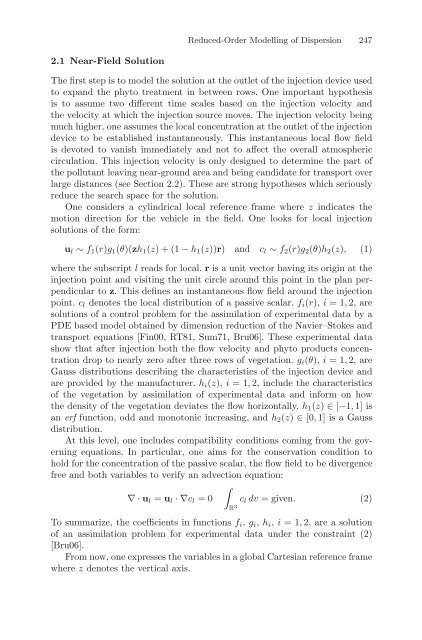Partial Differential Equations - Modelling and ... - ResearchGate
Partial Differential Equations - Modelling and ... - ResearchGate
Partial Differential Equations - Modelling and ... - ResearchGate
Create successful ePaper yourself
Turn your PDF publications into a flip-book with our unique Google optimized e-Paper software.
Reduced-Order <strong>Modelling</strong> of Dispersion 247<br />
2.1 Near-Field Solution<br />
The first step is to model the solution at the outlet of the injection device used<br />
to exp<strong>and</strong> the phyto treatment in between rows. One important hypothesis<br />
is to assume two different time scales based on the injection velocity <strong>and</strong><br />
the velocity at which the injection source moves. The injection velocity being<br />
much higher, one assumes the local concentration at the outlet of the injection<br />
device to be established instantaneously. This instantaneous local flow field<br />
is devoted to vanish immediately <strong>and</strong> not to affect the overall atmospheric<br />
circulation. This injection velocity is only designed to determine the part of<br />
the pollutant leaving near-ground area <strong>and</strong> being c<strong>and</strong>idate for transport over<br />
large distances (see Section 2.2). These are strong hypotheses which seriously<br />
reduce the search space for the solution.<br />
One considers a cylindrical local reference frame where z indicates the<br />
motion direction for the vehicle in the field. One looks for local injection<br />
solutions of the form:<br />
u l ∼ f 1 (r)g 1 (θ)(zh 1 (z)+(1− h 1 (z))r) <strong>and</strong> c l ∼ f 2 (r)g 2 (θ)h 2 (z), (1)<br />
where the subscript l reads for local. r is a unit vector having its origin at the<br />
injection point <strong>and</strong> visiting the unit circle around this point in the plan perpendicular<br />
to z. This defines an instantaneous flow field around the injection<br />
point. c l denotes the local distribution of a passive scalar. f i (r), i =1, 2, are<br />
solutions of a control problem for the assimilation of experimental data by a<br />
PDE based model obtained by dimension reduction of the Navier–Stokes <strong>and</strong><br />
transport equations [Fin00, RT81, Sum71, Bru06]. These experimental data<br />
show that after injection both the flow velocity <strong>and</strong> phyto products concentration<br />
drop to nearly zero after three rows of vegetation. g i (θ), i =1, 2, are<br />
Gauss distributions describing the characteristics of the injection device <strong>and</strong><br />
are provided by the manufacturer. h i (z), i =1, 2, include the characteristics<br />
of the vegetation by assimilation of experimental data <strong>and</strong> inform on how<br />
the density of the vegetation deviates the flow horizontally. h 1 (z) ∈ [−1, 1] is<br />
an erf function, odd <strong>and</strong> monotonic increasing, <strong>and</strong> h 2 (z) ∈ [0, 1] is a Gauss<br />
distribution.<br />
At this level, one includes compatibility conditions coming from the governing<br />
equations. In particular, one aims for the conservation condition to<br />
hold for the concentration of the passive scalar, the flow field to be divergence<br />
free <strong>and</strong> both variables to verify an advection equation:<br />
∫<br />
∇·u l = u l ·∇c l =0 c l dv =given. (2)<br />
R 3<br />
To summarize, the coefficients in functions f i , g i , h i , i =1, 2, are a solution<br />
of an assimilation problem for experimental data under the constraint (2)<br />
[Bru06].<br />
From now, one expresses the variables in a global Cartesian reference frame<br />
where z denotes the vertical axis.
















